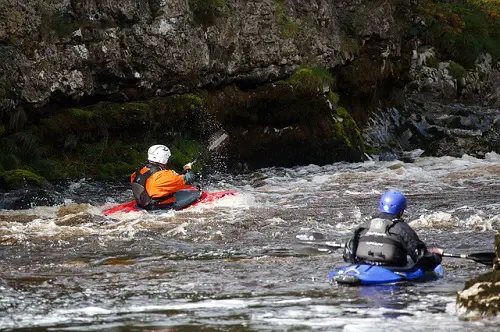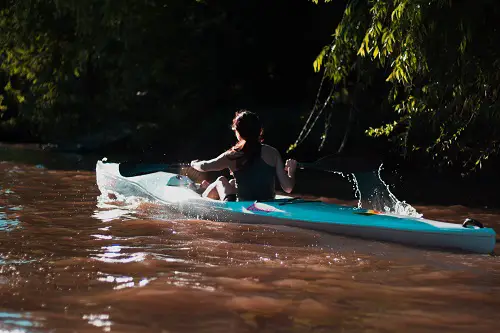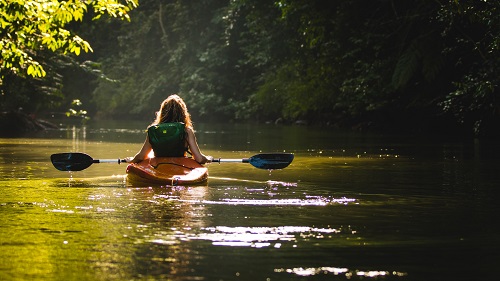River kayaking is an excellent water sport to exercise, enjoy nature, and have a lot of fun. Not a long time ago, I introduced my friend to rapids. He asked me a bunch of questions, including this one: Can I paddle up the river?
At first, I didn’t think it was possible because I generally kayak in whitewater and fast downstream currents. So my response was: Good luck with that, man. But after reflection, I wonder if his idea might be realistic in another type of environment. Therefore, here’s what you should know before you consider paddling up a river!

Can You Kayak Upstream?
Paddling up a river is possible if you have the right kayak and the conditions are appropriate for it. You can travel up a calm river that has a slow current (under 2-3 mph), but not one with rapids and fast-flowing water. Although upstream kayaking can be extremely hard and physically demanding, it’s not impossible.
I’ve never paddled against the current over a long distance. However, there are a few sections in my river where I can kayak upstream. But even if it’s feasible, I would generally recommend following the direction in which the water goes.
Is It Hard To Kayak Up River?
The main reason you should paddle with, and not against the current, is that it requires less effort. To give you an idea, it’s like running up the down escalator. You will have to work at least twice what you would have to than if you took the right side.
Kayaking up a river on short distances can be relatively easy if the current is slow. But paddling upstream for long periods is hard and sometimes impossible. You can be surprised by how powerful water can be, especially in rivers.
Benefits Of Upstream Kayaking!
During my research, I was wondering why someone would possibly want to paddle up a river. Well, there are two main advantages to such an unusual practice. But they are both excellent reasons to try this variation of the sport.
It’s A Good Exercise!
If you decide to kayak against the current, be prepared for an intense workout. On short distances in fast-flowing water, it will be excellent strength training for your upper body muscles. On the other side, paddling up a calm and steady river over a long period is a good cardio exercise to improve your endurance. So kayaking can be physically demanding if you decide to paddle upstream.
No Need For A Shuttle!
You should not forget the logistical part of planning a kayak trip. Finding a way to get back in your car after paddling down the river isn’t always easy. But there’s no problem if you kayak against the current and let yourself float back to your starting point when you’re tired.
Why Do I Perform Upstream Kayaking?
Another good reason to paddle against the current is to go somewhere faster or more conveniently. Instead of walking in the forest with my kayak to play in the rapids, I can launch somewhere it’s possible to navigate upstream in the water.
How To Know If You Can Kayak A River Against The Current?
Before heading out somewhere to paddle upstream, you need to make sure it’s possible. Not every river is suitable for this activity. If the water flow is too fast or there are rapids, the conditions aren’t ideal for paddling against the current.
Consider Your Speed & The River Flow.
Most kayakers can paddle anywhere from 2 to 4 miles per hour over a long period. Depending on where you’re situated, you have to find a river in which the current is slower than your average speed. Otherwise, you won’t be able to kayak upstream.
Paddling against the current is much easier if you find an appropriate river for this purpose. You should be looking for a calm and slow water flow, especially if you’re just getting started. The perfect conditions would a river with a current under 2 knots (2-3 mph) of speed.

How To Estimate The Speed Of A River?
Unless you have a device to tell you how fast the current is, it can seem impossible to determine the river speed. Well, here’s a simple method to estimate that number. It won’t be the most accurate data, but it’s easy to do and will give you an excellent idea of the water flow.
First, you need something to calculate the distance, such as a measuring tape. If you know the length of your kayak, it can also work. You will also have to find an object you can throw in the water, such as a rope bag or anything else that floats. Then, a timer is required to estimate the speed of the river.
Once you have all the gear necessary, it’s time for experimentation. Here are the 4 steps to follow:
- Place the measuring instrument in parallel with the river.
- Drop the object in the water flow.
- Use the timer to calculate how long it takes to get from one point to another.
- Make the math.
To help you understand more, let’s try with a real-life example. John has a 12-foot recreational kayak and paddle at approximately 3 mph. He wants to know if traveling upstream in the Nowhere River is possible for him.
Here’s what John should do to find out an answer to his question:
- Place his boat (12 feet) parallel to the river.
- Throw a wood stick found on the ground in the current.
- Calculate with his phone how much time it takes the object to float past his kayak.
- Finally, he has to gather the data. Let’s say the wood stick took 3 seconds to float alongside the 12-foot boat. You can convert 12 feet / 3 seconds in feet per second (fps), which is 4 fps. With that number, you can estimate the speed in mph because 1 fps = 0.68 mph.
In this situation, the river flow would be approximately 2.72 mph (4 fps). Thus, the average paddling speed of John should be enough to kayak upstream. For more accurate results, you can always repeat the process multiple times and average each final data.
I found this river speed estimation technique in this article from The Houston Canoe Club blog. You can read it for more details and examples.
If You’re Not Sure, Give It A Try!
When it comes to sports and data, a test will never lie. Thus, you can head out on the river you plan to kayak upstream and try it instead of using the analytic approach. You have nothing to lose, and it will be crystal clear if you can or not paddle against the current.
What If You Encounter A Rapid On Your Way Up The River?
Another problem you might encounter on upstream kayaking trips is a section that’s impossible to navigate upriver. It doesn’t mean you have to call it a day. You can also carry your boat on the land and launch again when the river gets manageable to paddle against the current.
Upstream Kayaking Tips!
Paddling up a river can be fun, but it’s a whole different experience than following the water flow. That’s why you should know a few things before heading out for your first upstream adventure. So here’s all the information you need to kayak against the current!
Start With A Calm & Slow River.
For your first experience, I highly recommend finding a spot well-suited for upstream kayaking. Getting started in a fast-flowing river with several rapids won’t be fun nor safe. A slow and calm body of water is more appropriate to improve your paddling skills against the current.
In general, wide rivers are more likely to have a current suitable for upstream kayaking. Narrow sections will probably be faster and have more rapids because the water has less space to travel for the same amount. Thus, being aware that the river width can influence the current might help you find the perfect location to start.
Paddle On The Edges.
The river speed is an essential factor to consider, but the current isn’t the same everywhere on the surface. It’s generally faster in the center section because it’s deeper and there’s more water flowing. On the edges, there are obstacles to slow down the stream.
So if you want to paddle up a river efficiently, you should stay away from the middle and kayak as close as possible to the sides. Otherwise, you will have to paddle harder because the center is where the downstream current is the strongest.
Use The River Obstacles At Your Advantage.
Another idea to paddle more easily against the current is to make the most from your environment. In rivers, many rocks create flat water spots. So you can use them to avoid getting pushed back and take breaks.
If the current is relatively fast, you might also find what kayakers call eddies. They are sections where the water moves upstream. It will generally take form behind an obstacle that disrupts the surface flow.
You can travel from one to another or use them to stop and relax. Either way, an eddy is an opportunity to paddle up the river more efficiently and effortlessly. However, you will generally find these sections in fast-flowing water and rapids only.
Select The Right Kayak.
How fast you can paddle will not only depend on your physical strength and experience. The type of boat you’re navigating is also an essential factor to consider. For upstream kayaking, you need something suitable for the river and fast enough to go against the current.
That’s why you should be looking for a long, stable, and maneuverable vessel. If you’re new to this sport, there are unlimited choices of kayak design to choose from on the market.
For upstream paddling, I would recommend a whitewater longboat such as the Pyranha R12. Depending on your needs, recreational, touring, and crossover kayaks can also be appropriate for this activity.
Have Fun!
Whatever your paddling with or against the current, it doesn’t matter as long as you enjoy it. Even if upstream kayaking can be arduous, it’s possible regardless of what other people say. In my opinion, the only thing that matters is to have fun.
Last Thoughts About River Kayaking Against The Current!
Finally, you can paddle upstream if the conditions and gear you have are appropriate for this purpose. But you should know what to expect because kayaking down and up a river is totally different. If you find a calm and safe place where the current isn’t too fast, everything should be alright.

I hope my article has helped you understand when it’s possible to kayak up a river. Whether you follow or not the current, I’m sure you will have a lot of fun paddling in the water. Now it’s time to prepare yourself for such an adventure and find the perfect spot to get started with whitewater kayaking.
See You On The River!
